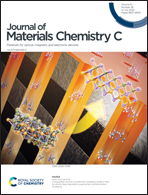A novel dual-tone molecular glass resist based on adamantane derivatives for electron beam lithography†
Abstract
A novel molecular glass compound (AD-10Boc) based on adamantane derivatives was synthesized and characterized. The thermal analysis indicated that a glass transition temperature (Tg) of 80.6 °C and a thermal decomposition temperature (Td) up to 150 °C were observed. The X-ray diffraction analysis of the powder of AD-10Boc suggests that it exists in an amorphous state at room temperature. The good thermal resistance and film-forming performance of AD-10Boc suggest that it is a candidate for resist materials. AD-10Boc resist was produced by mixing it with minor components of photo-acid generator and other additives. The AD-10Boc resist was demonstrated as a dual-tone (positive and negative tone) resist for electron beam lithography. By optimizing the lithographic performance, the AD-10Boc resist can resolve dense line patterns of 21 nm L/S at 50 μC cm−2 and 30 nm L/S at 100 μC cm−2 for negative-tone and positive-tone development, respectively. This study provides a new example of a dual-tone molecular glass resist fulfilling most of the requirements of EBL.



 Please wait while we load your content...
Please wait while we load your content...